Guru Plug Server Plus: don't waste your money and nerves on it
Inspired by this article, I ordered myself from New IT GuruPlug Server Plus.
And here is my story:
My pre-order took place in July, but arrived only at the end of October. As you know, shipments were suspended due to overheating problems. I will not give any pictures of the configuration, as they were already in the article mentioned above. The packaging was very good, the server box was packed in a bubble bag and already on top in black PVC bag. Opening the box, I noted that the device looked very compact a little more than a credit card, not counting the height.
')
And now, in anticipation, I decided to turn it on. What was my disappointment when after turning on I heard a terrible howl of a fan. But from my experience with servers, I assumed that after loading the noise level would decrease, but here the first and not the last disappointment awaited me.
Caution traffic.
The device ships with the installed Debian system, so nothing needs to be installed to test it. By connecting the cable to the Ethernet port, I tracked what IP address my router issued, but then a second disappointment awaited me. The received IP address by the server was neither pinged, nor answered to the Telnet, SSH, WWW request. It turned out that there are pluses. The device is configured as a Wi-Fi Access Point. Having used this type of connection and having received the settings via DHCP, I was able to log in via SSH.
That's about NAND memory:
2 Gb is a SAMSUNG memory chip, and in the file system it is divided into several sections
Also on the device were raised services such as MySQL, PHP, Lighttpd:
According to what he saw lifted Lighttpd service, an attempt was made to connect via the web interface.
The web interface is pretty simple:
Main page of web interface
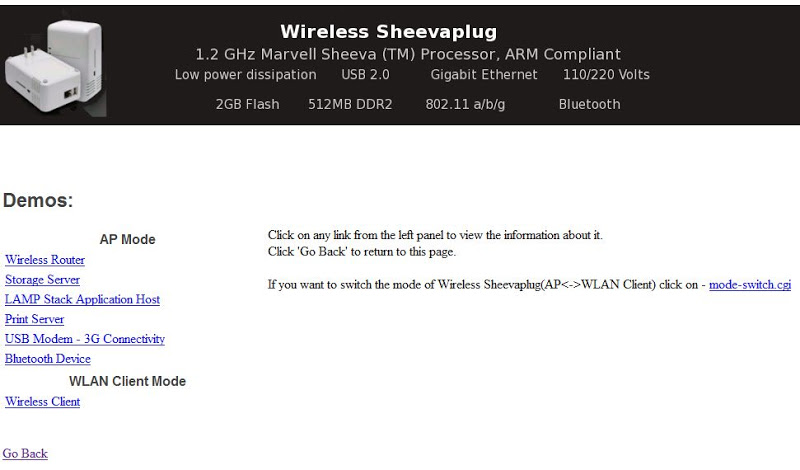
Wi-Fi mode change
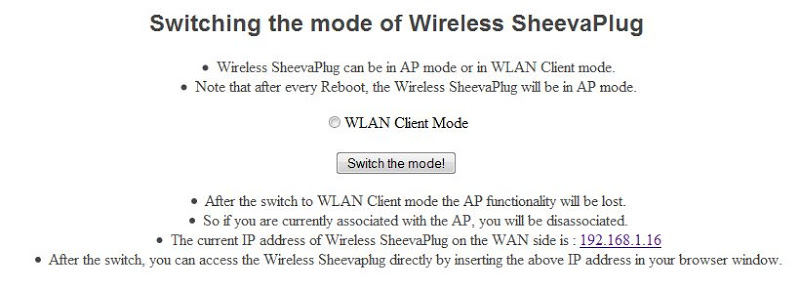
It is possible to change the DHCP server settings in the Wireless Router menu by calling the link
"If you want to change the IP address range, please follow the instructions here."
DHCP server settings page

But here I was waiting for the next disappointment . After changing the addresses of the DHCP server, it would be customary to expect that the address of the device itself would change to the selected subnet, but no matter how. I chose a new network 192.168.2.x did not find the device at 192.168.2.1 it remained at the old address 192.168.1.1.
In the LAMP section, you can enable the default database.
There is also a stream player “Flow Player”. In the sections Print Server and USB Modem - 3G Connectivity, you can configure the corresponding services. The Bluetooth Device section provides for setting up Bluetooth headphones for listening to music. This device can be configured to work with Wi-Fi as a client. To connect to any access point, it must be unprotected. "This demo only lists the 'Unsecured' (Open Security) wireless networks.". The menu states that “Please note that after each reboot, the wireless SheevaPlug will be in AP mode,” so keep that in mind.
To work via Ethernet, I had to conjure with a script
I commented out the lines that are related in IPTABLES.
Attention!!! If you removed the “/root/init_setup.sh” line in the /usr/rc.local file or deleted the term from the /root/init_setup.sh rm -f /etc/wlanclient.mode file, but not after reboot by disabling Cable, Hardware reboot button, it does not return the status of AP Mode. For some reason, SSH stopped working, but the web continued to work.
But what to do with the fan?
I decided to lose the guarantee to find out what was wrong with him. When I disassembled the device, my surprise was not chapel:
Opening the server, I noticed that the processor, RAM and ports, and the connectors themselves are pretty hot. A very bad internal server design guarantees significant overheating of components and heating of a power supply unit until it dies. As it turned out, repeated failures of this server are connected precisely with the failure of the power supply, but in fact the whole problem lies in the fact that the temperature mode of the chips leads to the drying of the electrolytic capacitor in the power supply.
To edit the scripts I had to solder the console cable based on this article , but since The FTDIChip TTL-232R_3v3 cable was used, then the following cable for the cable:
But contrary to this article, the cable earned after it was soldered in the following sequence: Black (GND), Orange (Tx), Yellow (Rx) starting from the JTAG connector. If you solder the cable Red (3.3v) then the server behaves in an original way. Without a power connection, it takes power from USB, all indicators of network connectors light up, but it did not achieve loading.
To restore SSH access, I had to create keys with a command
Next, I will give you photos that speak for themselves (the internal device of the server):
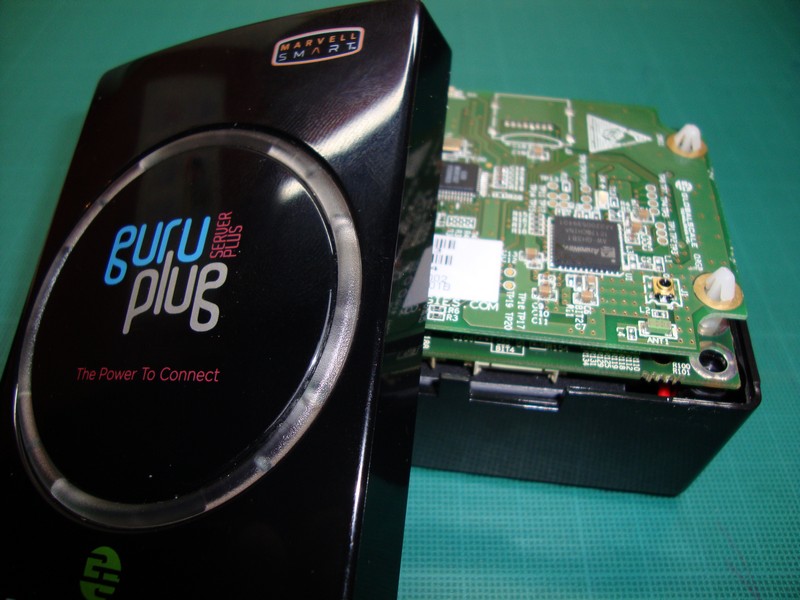


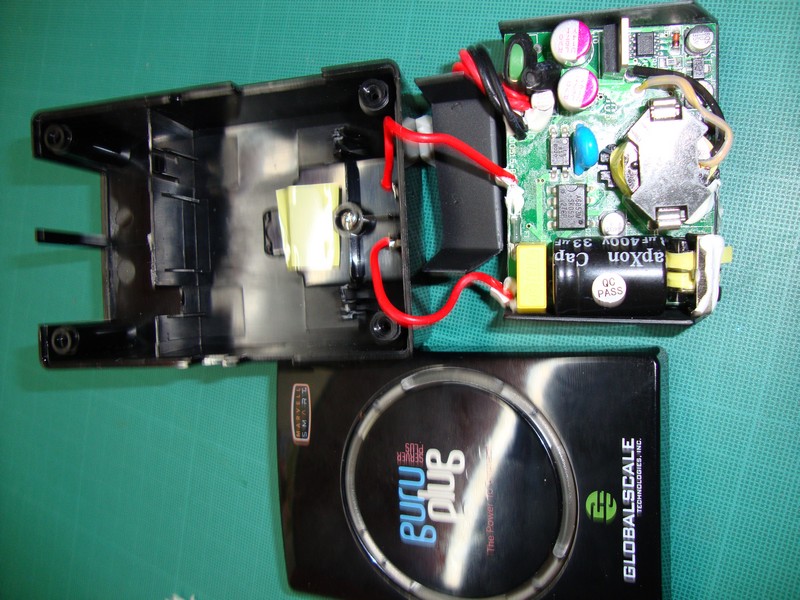
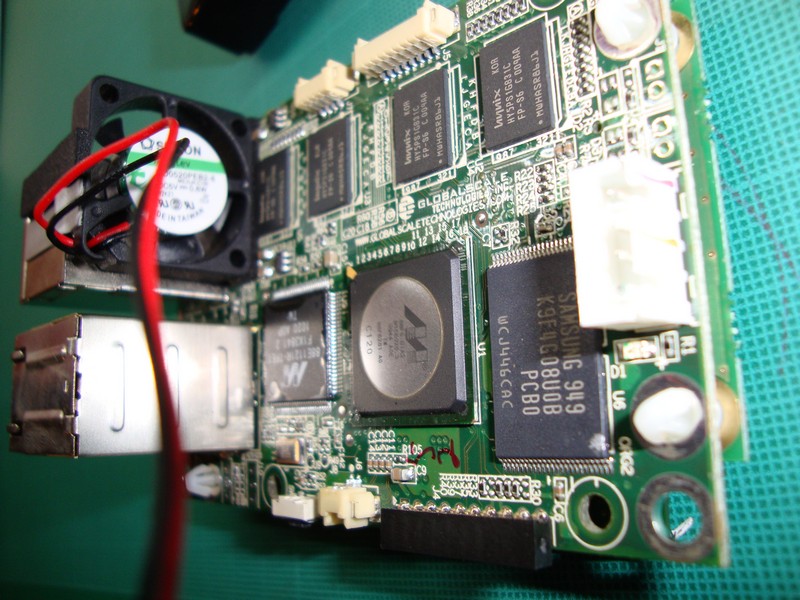
Soldered console cable TTL-232R-3v3.
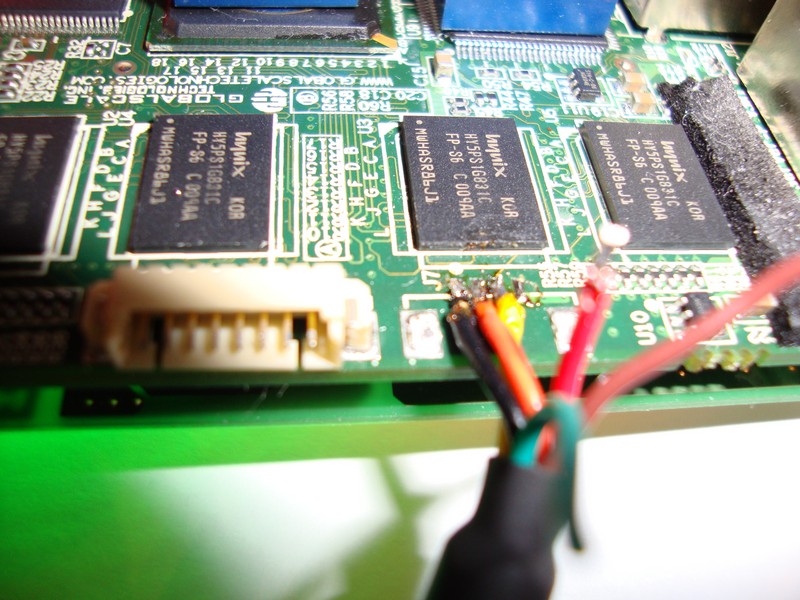
Having read a fair amount of forums, I realized that in the assembled state, the operation of this server is not possible, that only people don’t think up to cool this server (hereinafter the photos were not taken by me):
Fastening the radiator to the factory cooling plate. In my version of the plate was not.

Inset large plate for passive cooling.

Photos of thermal radiation:
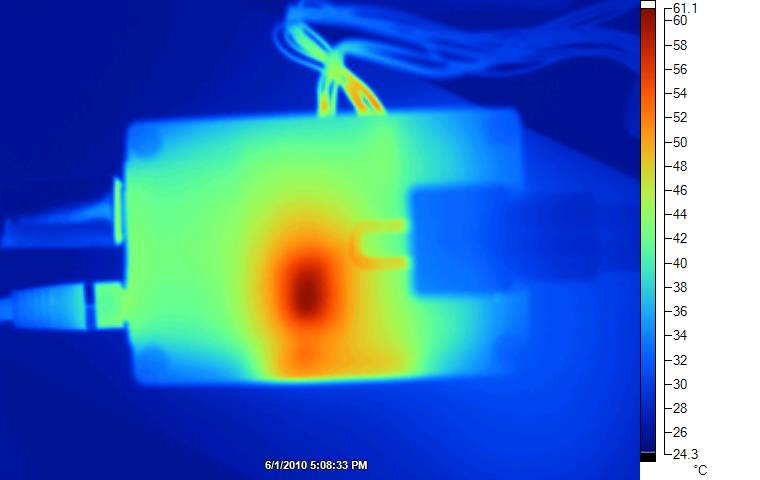
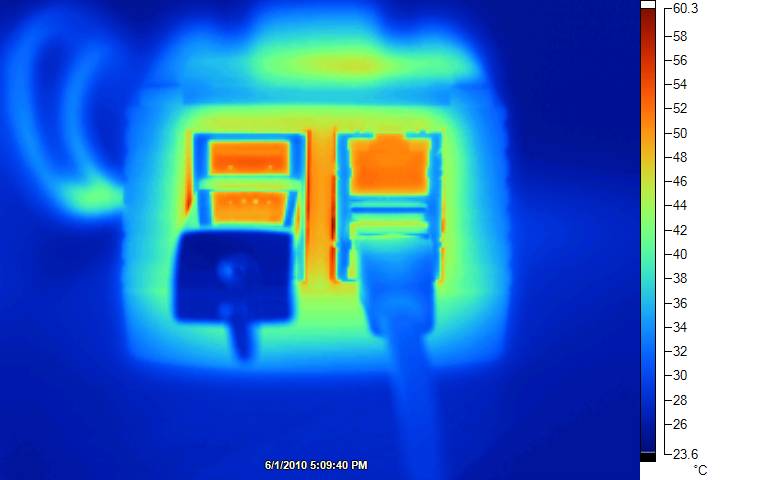
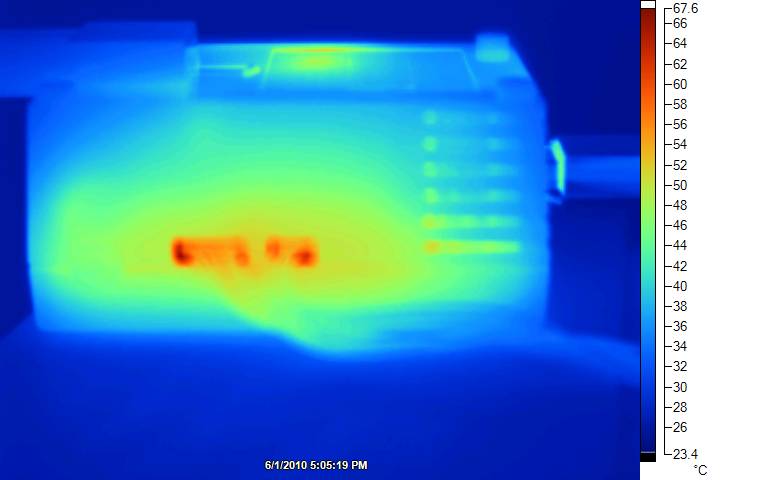
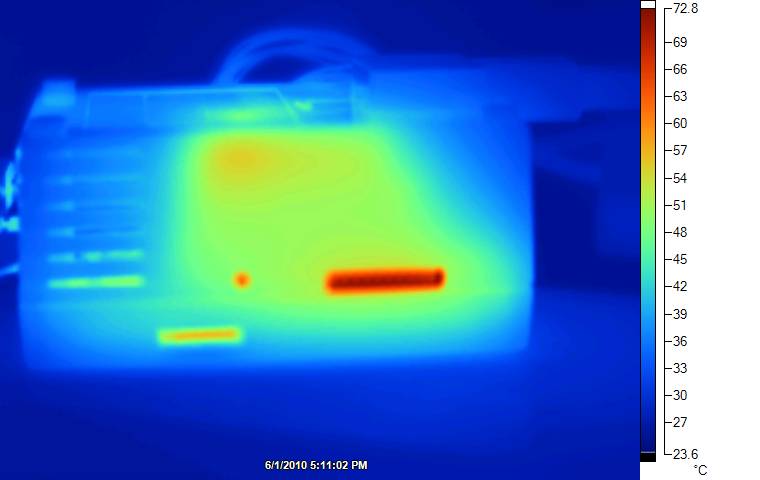
I’m completely disillusioned with the Guru Plug Server plus, and will never buy GlobalScale products again, as they are not complete.
So decide for yourself whether to spend money on this device.
A whole thread of the GP + overheating forum
And here is my story:
My pre-order took place in July, but arrived only at the end of October. As you know, shipments were suspended due to overheating problems. I will not give any pictures of the configuration, as they were already in the article mentioned above. The packaging was very good, the server box was packed in a bubble bag and already on top in black PVC bag. Opening the box, I noted that the device looked very compact a little more than a credit card, not counting the height.
')
And now, in anticipation, I decided to turn it on. What was my disappointment when after turning on I heard a terrible howl of a fan. But from my experience with servers, I assumed that after loading the noise level would decrease, but here the first and not the last disappointment awaited me.
Caution traffic.
The device ships with the installed Debian system, so nothing needs to be installed to test it. By connecting the cable to the Ethernet port, I tracked what IP address my router issued, but then a second disappointment awaited me. The received IP address by the server was neither pinged, nor answered to the Telnet, SSH, WWW request. It turned out that there are pluses. The device is configured as a Wi-Fi Access Point. Having used this type of connection and having received the settings via DHCP, I was able to log in via SSH.
Linux sheevaplug-debian 2.6.32-00007-g56678ec #1 PREEMPT Mon Feb 8 03:49:55 PST 2010 armv5tel
The programs included with the Debian GNU/Linux system are free software;
the exact distribution terms for each program are described in the
individual files in /usr/share/doc/*/copyright.
Debian GNU/Linux comes with ABSOLUTELY NO WARRANTY, to the extent
permitted by applicable law.
Last login: Mon Feb 1 16:42:41 2010
sheevaplug-debian:~# uname -a
Linux sheevaplug-debian 2.6.32-00007-g56678ec #1 PREEMPT Mon Feb 8 03:49:55 PST 2010 armv5tel GNU/Linux
sheevaplug-debian:~#
That's about NAND memory:
2 Gb is a SAMSUNG memory chip, and in the file system it is divided into several sections
sheevaplug-debian:/sbin# df -h
Filesystem Size Used Avail Use% Mounted on
tmpfs 251M 0 251M 0% /lib/init/rw
udev 10M 720K 9.3M 8% /dev
tmpfs 251M 4.0K 251M 1% /dev/shm
rootfs 463M 204M 259M 45% /
tmpfs 251M 0 251M 0% /var/cache/apt
Also on the device were raised services such as MySQL, PHP, Lighttpd:
sheevaplug-debian:/sbin# top | grep mysqld
1533 root 40 0 2852 1300 1076 S 0.0 0.3 0:00.04 mysqld_safe
1576 mysql 40 0 124m 16m 4708 S 0.0 3.3 0:02.05 mysqld
sheevaplug-debian:/sbin# top | grep php
2000 www-data 40 0 28108 5396 3620 S 0.0 1.1 0:00.35 php-cgi
2006 www-data 40 0 28108 5396 3620 S 0.0 1.1 0:00.35 php-cgi
2029 www-data 40 0 28108 2192 416 S 0.0 0.4 0:00.00 php-cgi
According to what he saw lifted Lighttpd service, an attempt was made to connect via the web interface.
The web interface is pretty simple:
Main page of web interface

Wi-Fi mode change

It is possible to change the DHCP server settings in the Wireless Router menu by calling the link
"If you want to change the IP address range, please follow the instructions here."
DHCP server settings page

But here I was waiting for the next disappointment . After changing the addresses of the DHCP server, it would be customary to expect that the address of the device itself would change to the selected subnet, but no matter how. I chose a new network 192.168.2.x did not find the device at 192.168.2.1 it remained at the old address 192.168.1.1.
In the LAMP section, you can enable the default database.
host:localhost
username:root
password:nosoup4u
databasename:ploggerThere is also a stream player “Flow Player”. In the sections Print Server and USB Modem - 3G Connectivity, you can configure the corresponding services. The Bluetooth Device section provides for setting up Bluetooth headphones for listening to music. This device can be configured to work with Wi-Fi as a client. To connect to any access point, it must be unprotected. "This demo only lists the 'Unsecured' (Open Security) wireless networks.". The menu states that “Please note that after each reboot, the wireless SheevaPlug will be in AP mode,” so keep that in mind.
To work via Ethernet, I had to conjure with a script
I commented out the lines that are related in IPTABLES.
Attention!!! If you removed the “/root/init_setup.sh” line in the /usr/rc.local file or deleted the term from the /root/init_setup.sh rm -f /etc/wlanclient.mode file, but not after reboot by disabling Cable, Hardware reboot button, it does not return the status of AP Mode. For some reason, SSH stopped working, but the web continued to work.
But what to do with the fan?
I decided to lose the guarantee to find out what was wrong with him. When I disassembled the device, my surprise was not chapel:
- 1. The fan is directly powered from the power supply;
- 2. The absence of any radiators;
- 3. The fan is installed in such a way that its useful work is possible only by 1/3, since everything else is covered with USB connectors.
Opening the server, I noticed that the processor, RAM and ports, and the connectors themselves are pretty hot. A very bad internal server design guarantees significant overheating of components and heating of a power supply unit until it dies. As it turned out, repeated failures of this server are connected precisely with the failure of the power supply, but in fact the whole problem lies in the fact that the temperature mode of the chips leads to the drying of the electrolytic capacitor in the power supply.
To edit the scripts I had to solder the console cable based on this article , but since The FTDIChip TTL-232R_3v3 cable was used, then the following cable for the cable:
Red – 3.3v
Orange – Tx
Yellow – Rx
Black – GNDBut contrary to this article, the cable earned after it was soldered in the following sequence: Black (GND), Orange (Tx), Yellow (Rx) starting from the JTAG connector. If you solder the cable Red (3.3v) then the server behaves in an original way. Without a power connection, it takes power from USB, all indicators of network connectors light up, but it did not achieve loading.
To restore SSH access, I had to create keys with a command
ssh-keygen –t rsa
ssh-keygen –t dsa ssh-keygen –t rsa
ssh-keygen –t dsa , and the question of creating keys must be answered / etc / ssh / ssh_host_rsa_key and / etc / ssh / ssh_host_dsa_key, respectively.Next, I will give you photos that speak for themselves (the internal device of the server):





Soldered console cable TTL-232R-3v3.

Having read a fair amount of forums, I realized that in the assembled state, the operation of this server is not possible, that only people don’t think up to cool this server (hereinafter the photos were not taken by me):
Fastening the radiator to the factory cooling plate. In my version of the plate was not.

Inset large plate for passive cooling.

Photos of thermal radiation:




I’m completely disillusioned with the Guru Plug Server plus, and will never buy GlobalScale products again, as they are not complete.
So decide for yourself whether to spend money on this device.
A whole thread of the GP + overheating forum
Source: https://habr.com/ru/post/107295/
All Articles